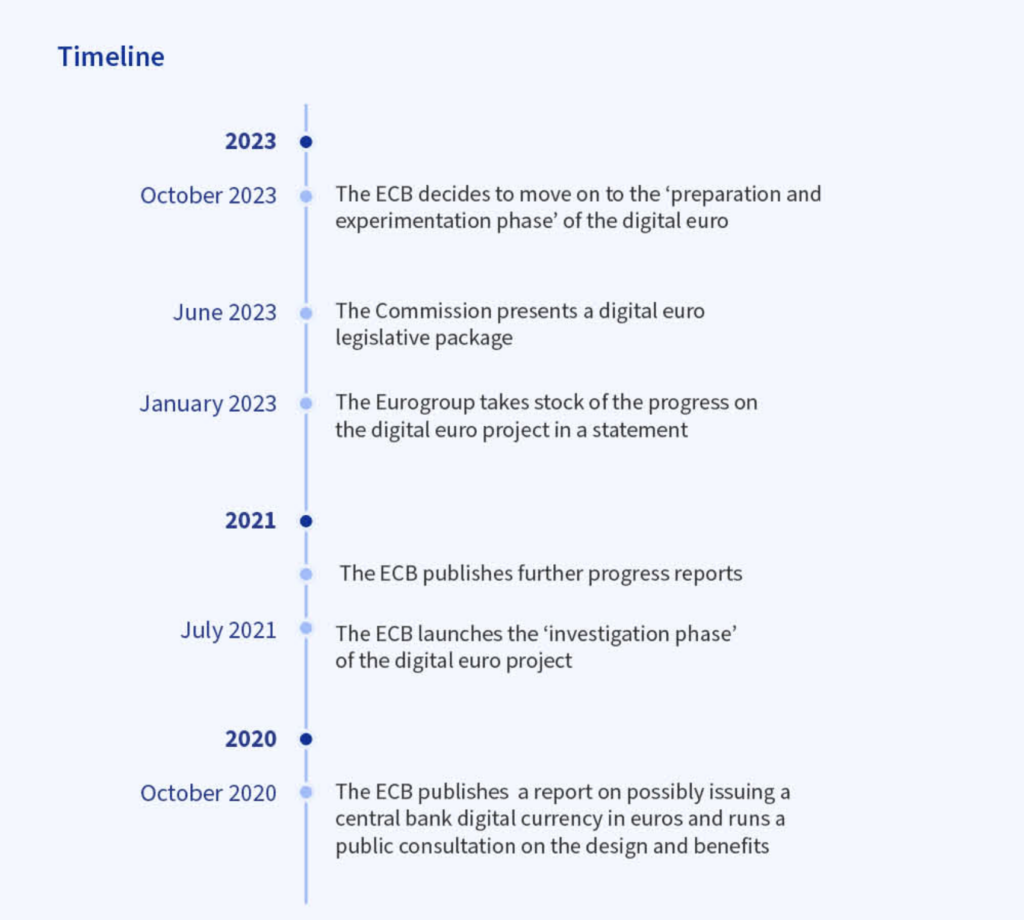
On October 18, 2023, the European Central Bank’s Governing Council announced the conclusion of a two-year investigation into the digital euro, officially entering the preparatory phase for the digital euro project.
As the world’s largest economic bloc and the largest alliance of developed countries, every significant step forward the EU takes in the digital euro project will reinforce the global trend in CBDC development and contribute to the formation of a new paradigm.
The European Union’s determination to launch the digital euro is demonstrated in specific ways:

Firstly, in comparison to the United States and the United Kingdom, the European Union is the only economy that has legislated in cooperation with the introduction of a Central Bank Digital Currency (CBDC). In the case of the United States, although the Biden administration intends to push for the implementation of a digital dollar, the Republican Party has introduced legislative proposals in Congress to protect privacy and restrict CBDC.
As for the United Kingdom, despite the importance of issuing a digital pound being raised by members of the UK Parliament this year, and the House of Commons Library releasing a research brief on the digital pound, these initiatives have not translated into actual policy progress.
Secondly, the pace of exploration by the European Union is more practical. From the start of the investigation phase of the digital euro, the European Central Bank has promoted a series of gradual arrangements. When the legislative proposal for the digital euro landed, the European Union fully considered the potential negative impacts it might bring, emphasized the legal tender status of cash, and positioned the digital euro as a supplement to cash. These considerations and precautionary measures align with the EU’s motivation to promote the implementation of the digital euro. Therefore, the European Union takes a more practical approach in considering the potential issues the CBDC may encounter in circulation, and the overall pace is more pragmatic.
Thirdly, major EU countries such as Germany and France have expressed very clear and positive stances on the digital euro, in contrast to the ambiguous or even divided situations in the UK and the US. German Chancellor Scholz stated in his speech on the occasion of the 25th anniversary of the European Central Bank in May 2023, considering that the work on the digital euro is an ambitious and forward-looking project to strengthen European sovereignty. Macron emphasized as early as 2020 that Europe must maintain its digital sovereignty.
Overall, the European Union is the most resolute among developed economies in launching CBDC, and the digital euro may become a regionally influential CBDC with global impact.

The introduction of the digital euro is advantageous in maintaining the unity of the payment market. With the rise of cryptocurrencies, a division between legal and private currencies could lead to a fragmented payment landscape. If the existing banking system cannot subsequently provide payment means in the form of digital currency, the payment sector might transition from a “unified large market” to a divided payment system. Therefore, to maintain and even improve payment efficiency, the introduction of the digital euro is imperative.
The introduction of the digital euro is also beneficial in addressing the decrease in cash usage. As European society gradually transitions towards digital and cashless payment systems, the circulation of cash has greatly reduced. This can affect the stability of currency circulation within the Eurozone. Faced with this new situation, the launch of central bank digital currency will be conducive to developing the online economy, supplementing the use of cash, and stabilizing currency circulation.
The implicit goals of introducing the digital euro represent a sub-area under the macroscopic goal of European strategic autonomy. Due to NATO’s long-standing role as a cornerstone of European security, the EU has been struggling to achieve strategic autonomy in the field of security. Especially after the Russia-Ukraine war, Europe seems to be even further from achieving strategic autonomy in security.
However, in the economic field, particularly in the payment sector, once aided by central bank digital currency, the EU has the capability and conditions to promote payment autonomy. Although the concept of European strategic autonomy has been primarily championed by French President Macron and has been emphasized by China during Sino-European exchanges, leading to some doubts among certain member states, achieving strategic autonomy in economic fields like payments remains highly important for the EU.
Furthermore, the implicit goals of the digital euro include reducing dependence on American payment service providers. Currently, mainstream payment service providers in EU member states are largely dominated by American companies like Visa and Mastercard. Local European payment solutions have not gained a significant foothold.

Considering the zero cost of using the digital euro (as legal tender currency does not incur fees), its introduction is beneficial for European enterprises to reduce their reliance on American payment service providers and lower their costs.
Compared to other developed economies, the European Union demonstrates a stronger drive to promote the development of CBDC. Relatively speaking, the implementation speed of the digital euro is slower than that of the digital RMB, but it is ahead of the US dollar and the British pound. This is because the EU aims to maintain a certain degree of strategic autonomy, especially in the payment sector, while having no intention to overturn the current U.S.-dominated payment clearing system.
Therefore, in terms of the future development of the digital euro, the development of central bank digital currencies in other major countries will be a significant reference frame.
Currently, the cryptocurrency market is primarily based on the U.S. dollar as a stablecoin, effectively anchoring it to physical U.S. dollars. Therefore, as beneficiaries and dividend harvesters of the existing international currency payment system, the United States is likely not inclined to move too quickly in the CBDC direction and may even hold an opposing stance.
According to research from the Geoeconomic Center of the Atlantic Council, as many as 130 countries are exploring their versions of CBDCs, which account for 98% of the global economy. This includes 11 countries, including China, that have already fully implemented CBDCs.
It’s evident that the digital euro will face a certain level of “peer pressure,” which will further provide impetus for its development. The steady progress of the digital euro reflects a strong willingness among the EU’s major member states and leadership to enhance strategic autonomy and build digital financial infrastructure. Therefore, through thorough communication, negotiation, and practical initiatives over the next two years, the digital euro is expected to smoothly enter the issuance and implementation phase by the end of 2025.
Source: Europa



